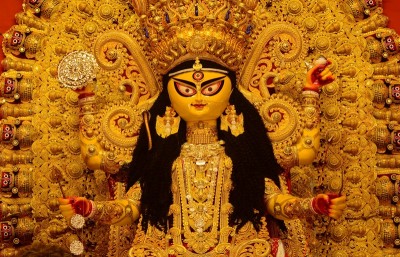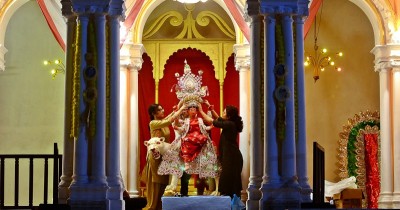 Northeast Women
Northeast Women
Women in India's Northeast are frontrunners in every sphere
Imphal/Shillong: In India's landlocked Northeast, women are more than half the sky. She leads from the front, she toils to conquer.
Women, who outnumbered their male counterparts in five of the seven North Eastern states, for decades have been playing a vital role in the mountainous region with a multiplicity of around 400 tribes and sub-tribes.
While Meghalaya is a matrilineal society, Manipuri, Naga and Mizo women for decades also played crucial roles in the business and economic front to varied societal aspects.
Except Assam and Tripura, in the gender ratio in the electoral rolls in the past many years, including in 2023, women outnumbered male voters in the Northeast.
In the Population Census of 2011 it was revealed that the population ratio in the seven northeastern states was between 938 and 989 females per 1000 of males. The Sex Ratio 2011 shows an upward trend in all the seven states from the census 2001 data.
Assembly polls in three northeastern states – Tripura, Nagaland, Meghalaya – will be held on February 16 and 27 respectively and the women would play a vital role in these crucial polls as they have traditionally always been at the forefront against many unlawful activities including drug menace.
“Women electorates are not only more than 50 per cent in the voters' list of several northeastern states, they are in the forefront in both domestic affairs and in the societal sphere," social activist and writer Nandita Datta said.
"If women get the due political empowerment and governance, many issues of northeast India would be resolved more easily and lastingly," she said.
Datta, who received many awards for her women centric writings, said that northeast India traditionally is a woman empowered society, though the women are given very less scope in politics and governance.
She said that northeastern women are educated, efficient and conscious of all basic issues and they are able to take care of their family, society and administration collectively.
Social activist Panchali Bhattacharjee said that if reservation of seats for the women in both Parliament and state legislative assemblies were made they would be able to do more for the welfare and betterment of the societies.
“In the patriarchal societies, women were earlier deprived in political and economical segments But over the years the situation gradually changed and women are also now law makers and policy makers,” said Bhattacharjee.
The century old and world's largest all-women run market 'Ima Keithal' or the 'Mother's Market', located in Manipur capital Imphal and other smaller all-women markets functioning in different parts of the northeastern state boost the Manipur economy to a large extent. It provides the livelihood of thousands of women.

To empower the women, ‘Ima Keithal’, also known as ‘Ima Market’, is also being established in 17 places of Manipur at a cost of Rs 130 crore.
The all women market, which has a history of over 500 years, has around 3,615 licensed female vendors registered with the Imphal Municipal Corporation.
Imphal-based writer Iboyaima Laithangbam said that the Ima Market has three different complexes in the same area selling consumer items, local Manipuri items and products and mixed goods including clothing.
"Since the British period, the Ima Keithel has not remained only a simple marketplace or trading hub, but developed as an apex centre for the campaign on various societal issues and against unsocial activities," Laithangbam said.
He said that the market has over the centuries been playing a pivotal role in empowerment of the women in the men dominated Manipuri society.
"For the socio-economic development of the Manipuri women, this market has always been playing a pioneering role," Laithangbam said.
Another Manipuri intellectual and writer Rajkuamr Kalyanjit Singh said that men can purchase anything from the "Ima Market" but they cannot be a vendor or seller.
"Manipuri women wearing their traditional attire operate their shops and stalls and occasionally organised various traditional festivals and events. The women vendors helped each others' necessities and guided the new vendors in doing the business," Singh said.
The vendors in the Ima Market are known as 'imas' or mothers, and the majority of the sellers are between the ages of 50 and 70 years.
Singh, editor of Manipuri newspaper 'Marup', said that in 1891, the British introduced stringent political and economic reforms leading to adverse impact on the market.
"Several measures including high taxation were imposed that eventually troubled the socio-economic fabric of the state in general and Manipuri society in particular. All these led to the formation of the 'Nupi Lana' (Women's War) movement in 1939 to revolt against the atrocities of the British. Protest rallies, mass gatherings and campaigns were held to denounce the British policies and measures.

"The British, in order to thwart the agitation, tried to sell the market's buildings to external buyers and foreigners but women of Manipur stood against the British and defended their market aggressively," the veteran scholar said.
The Naga Society in the neighbouring Nagaland, is a casteless and classless society where traditionally women have enjoyed a high social positioning and a fair spirit of independence playing a very central role in family and community affairs but not in governance of the state.
President Droupadi Murmu during her recent visit in Nagaland and Mizoram urged the women to come forward and get more involved in public life.
"If women are empowered, there is more development in society. Women lead with empathy, with care and they will give a new dimension to the development journey of Nagaland," she had said while addressing a civic reception organised by the Nagaland government in her honour at Capital Cultural Hall in Kohima.
The President had interacted with female students and women faculty members of Mizoram University along with some women led Self Help Groups in Aizawl.
Murmu said that she has been told about the steady progress and achievements of women in various fields in Mizoram and hoped that in the coming years women's contribution towards the overall development of the state would rise and their role would be enhanced.
She pointed out that besides jobs in the government sector, women must be empowered economically so that they can have their own start-ups and entrepreneurial ventures and said that more proactive steps need to be taken and existing support systems in place presently need to be strengthened and augmented.
Support Our Journalism
We cannot do without you.. your contribution supports unbiased journalism
IBNS is not driven by any ism- not wokeism, not racism, not skewed secularism, not hyper right-wing or left liberal ideals, nor by any hardline religious beliefs or hyper nationalism. We want to serve you good old objective news, as they are. We do not judge or preach. We let people decide for themselves. We only try to present factual and well-sourced news.







